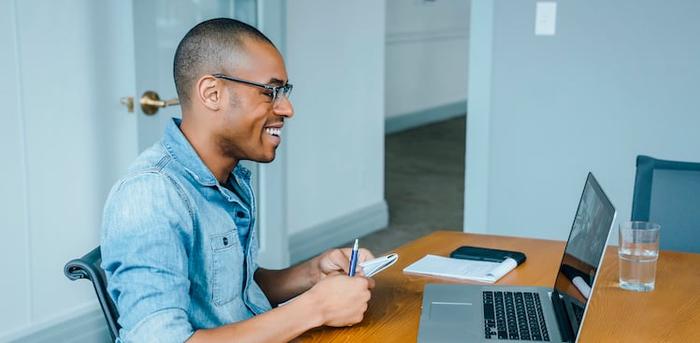
If you’ve looked for a new job recently, you probably noticed that video interviews are becoming more and more common. And it makes sense why. Advancing technology lets most job searchers do a Skype, Zoom, or Google Hangouts interview with little trouble. Plus, a video interview gives you the face-to-face aspect missing from a phone interview—without having to take time off work (or travel across the country!) to meet in person.
But that doesn’t mean you should treat a video interview casually. “Just because you don’t have to go somewhere doesn’t mean you don’t have to prepare,” says career coach Emily Moyer. A video interview also introduces a new dimension: You’re now creating the visual environment just as much as the interviewer is. You can view this as a burden, or you can view it as an opportunity to “create an environment and a visual aesthetic that portrays how you want to present yourself,” Moyer adds.
Follow this advice to set up for your next video interview so you’ll look and sound (and feel!) totally professional.
1. Prepare Your Environment
Choose a spot for the interview where you can control the surroundings. If at all possible, take the video interview in your home, but anywhere quiet with a good internet connection is a viable option. Don’t take a video interview in a coffee shop except as a last resort.
“Think through what else is going to be going on near you at the time of the interview,” says Amy M. Gardner, certified career development and career transition coach with Apochromatik. Avoid noisy or busy areas, and if you can, check out the area at the same time the day before your interview for any unwelcome interference—or a faulty internet connection.
Lighting
When it comes to lighting, natural light from a window is ideal; fluorescent or tungsten lights can be unflattering.
Facing your light source is always better than having it at your back (which creates shadows), but check for glare from your eyeglasses, watch, or jewelry.
Camera
Set up your computer so that the camera is close to eye level. If you have to use your phone, prop it up on a stack of books. You’ll avoid that shaky handheld effect, and the extra height will get the camera at the right angle.
Multiple monitors? Place the one with the camera on it straight ahead of you so you’re not turning your body or looking away from the interviewer.
Bonus tip: Put the window with the interview in it as close to the camera as possible, to help you mimic eye contact with the interviewer.
Must-Haves
Clear your desk of distractions, and only keep what you’d have at an in-person interview: a glass of water, a copy of your resume, and something to take notes with. “Be fully present. Don’t have your phone out next to you,” Moyer says.
2. Prepare Yourself
If at all possible, try to practice with a friend or family member beforehand.
- Test your audio, video, and internet connection using the same software as the interview.
- Make sure the other person can hear you and there’s nothing distracting them in the frame.
- Ask them to tell you if your gestures or body language look awkward on camera.
Dress professionally from head to toe: You’ll feel and act more put together if you’re not wearing sweatpants. Just avoid jewelry that makes a lot of noise or is visually distracting.
3. Prepare the Shot
Frame your shot as closely to an in-person interview as you can.
- Don’t sit super close to the screen—you want your head and shoulders visible. A good rule of thumb is to leave 10-20% of the screen empty above your head. You won’t be tiny, but you also won’t cut yourself off accidentally by sitting up straighter or gesturing.
- Choose a simple background with no distractions. Gardner says she once had a client give an interview in a room full of dressmaker’s mannequins—and had trouble focusing on the interviewee as a result.
- Using headphones helps prevent weird echoes, and if your headphones have a microphone on them, that will make it easier to hear you. (Make sure the mic isn’t rubbing against your shirt or banging against your necklace throughout the interview.) Avoid giant over-the-ear headphones or gaming headsets—or at least consider the visual aesthetic you’re creating by wearing them.
- Unlike a phone interview, body language is important in a video interview. Try not to lean in—this can make you look too large and close on the interviewer’s screen. Instead, sit up straight, and smile and nod to show you’re paying attention.
Read more about how to ace your next video interview here.